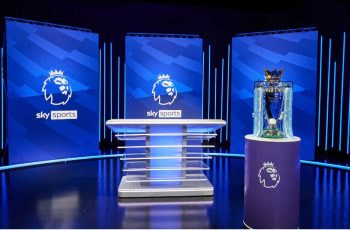Gambling Ads in Match Programs’ Kids Sections
Researchers have published a new study into gambling ads in football match programs. The study has found that football clubs’ matchday programs in the UK contain large numbers of gambling ads, even on children’s pages. The findings raise concerns about children being overly exposed to gambling advertisements and content.

The study expresses concerns over the high number of gambling ads children are exposed to at football matches. ©Adrià Crehuet Cano/Unsplash
Gambling Logos Prevalent on Shirts
Researchers from the University of East London, Anglia Ruskin and the University of Warwick have published a research paper examining the prevalence of gambling marketing in UK football match programs. The study has been published in the ‘Journal of Gambling Studies’ titled Exposure to Gambling and Alcohol Marketing in Soccer Matchday Programmes. The study’s authors are Dr Steve Sharman, Ms. Catia Alexandra Ferreira, and Dr. Philip W. S. Newall.
“The UK’s Premier League and Championship are two of the most well-attended soccer leagues worldwide; however, little is known regarding exposure to gambling marketing through the matchday experience. The current study sought to quantify exposure to gambling and alcohol marketing and responsible gambling messages within matchday programs.”
The study analyzed 44 matchday programs for Premier League and Championship games. On average the programs contained 2.3 gambling adverts, a figure that is four times higher than adverts for alcohol. On average programs featured around 38 instances of ‘incidental’ exposure. These mainly consisted of images of football players wearing team shirts sponsored by gambling and betting firms. These types of images were found on 22% of average program pages, although in some cases this was seen to rise to more than 50%.
The researchers noted that “of particular concern is the identification of significant exposure to gambling marketing in the dedicated child sections of matchday programs”. Of the 44 programs examined in the study, 39 included pages aimed at children. 59% of these children’s pages featured gambling brands and logos, with no mention of responsible gambling. The 44 studied programs have a wide-reaching audience of over 1.2 million football fans.
One example highlighted in the study shows young Birmingham City fans targeted. In a ‘Spot the Difference’ competition, one of the differences was a logo for online casino 888. Similarly, a Blackburn Rovers page showed a 12-year-old mascot dressed in a sponsored team shirt, featuring a 32 Red logo.
Kev Clelland works for YGAM, a youth gambling charity. YGAM, short for the ‘Young Gamers and Gamblers Education Trust’, is a charity which aims to “inform, educate, safeguard and build digital resilience amongst young and vulnerable people”. Through the provision of education programs and resources, YGAM helps to inform young people about the consequences of gambling. Clelland says that the prevalence of gambling branding is a commonly brought up topic in his youth sessions.
“I often quote my own kids – a recent example of this is my son, who is 10, was at his gran’s the other week and was drawing a picture of a football match, which included the advertising hoarding and the branding of a well-known gambling operator written on it.”– Kev Clelland, Operations Director, YGAM
In response to the study’s findings, a spokesman for the Birmingham City football club made the following statement. “We take very seriously our responsibility in this field and the example brought to our attention, which was from more than a year ago, will have been an oversight on our part and certainly not indicative of something that is typical of our club”. Birmingham City is no longer sponsored by 888 Casino.
‘Whistle to Whistle’ Ban
A voluntary ‘whistle to whistle’ ban on TV gambling ads during live sports was implemented earlier this year. The ‘whistle to whistle’ time begins five minutes before televised matches and ends five minutes after. The ban was brought in to combat a large number of gambling ads aired during broadcast matches. However, some have criticized the voluntary ban as not going far enough. Gambling logos and branding still feature prominently on players’ shirts, pitch-side hoardings and on interview backdrops. The football pitch is still far from a gambling ad-free zone.
“Whilst the whistle-to-whistle ban on TV adverts may reduce the number of actual adverts during live sport, football fans are still exposed to a variety of gambling marketing through other channels.”
It is a fact that gambling firms sponsor most UK, football teams. Gambling companies sponsor 17 out of 24 Championship teams and half of this season’s Premier league teams. One particular sponsorship deal hit the headlines earlier this year. Wayne Rooney agreed to wear the number 32, to advertise online casino 32 Red. The controversial deal helped to fund his transfer to Derby County.
“While a significant amount of discussion is currently centered around TV gambling advertising, the average football fan can be exposed to significant amounts of gambling marketing through other channels. This research shows that the average match-going fan is exposed to almost 40 gambling brand placements and around 2.5 gambling adverts through the matchday program alone. This comes at a time when 78% of young people say that betting has become a normal part of sport.”– Dr Steve Sharman, Co-Author, ‘Exposure to Gambling and Alcohol Marketing in Soccer Matchday Programmes’ Report
The study concludes that “Frequent exposure normalizes gambling as part of the matchday experience, even for children attending matches, as demonstrated by gambling marketing being present in child-specific sections of the programs. The increase in shirt sponsoring by gambling companies increases incidental marketing exposure.”. It goes on to recommend that football clubs be more aware of the gambling content that their fans are exposed to, particularly in the case of children. That awareness must also apply to policymakers and legislators.



